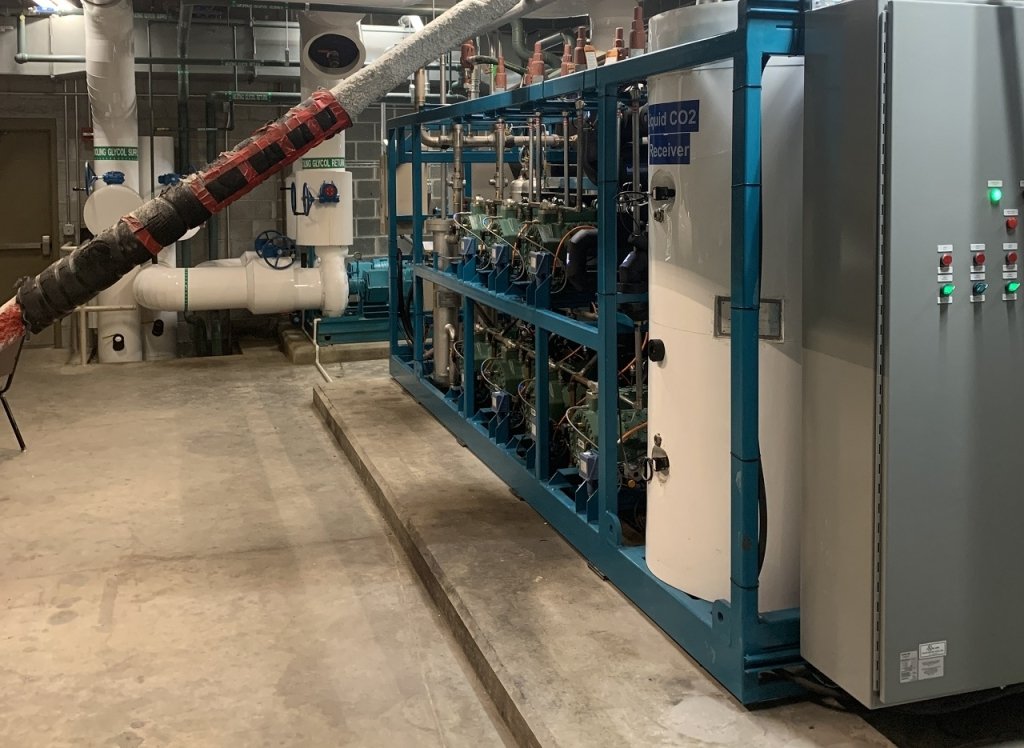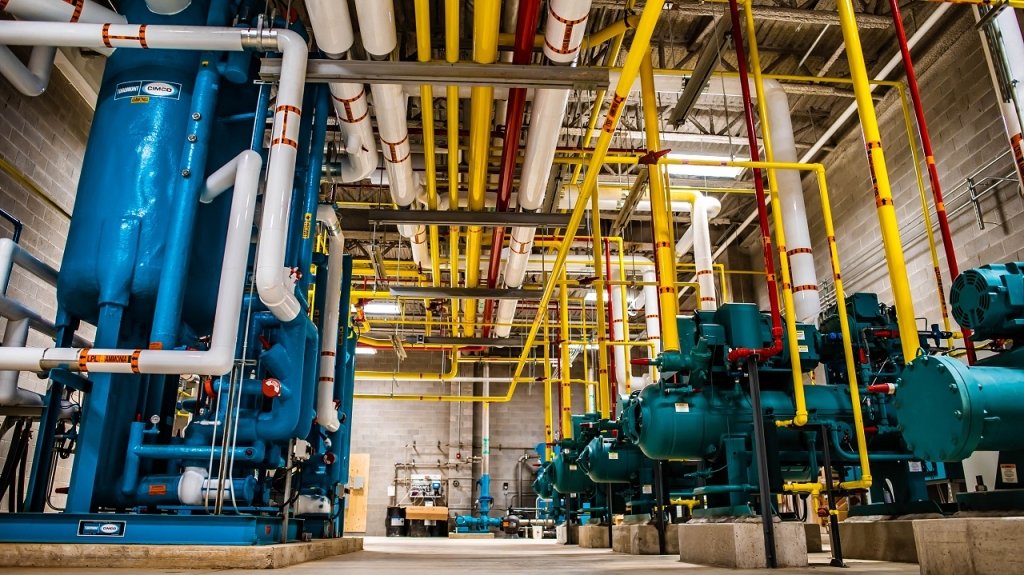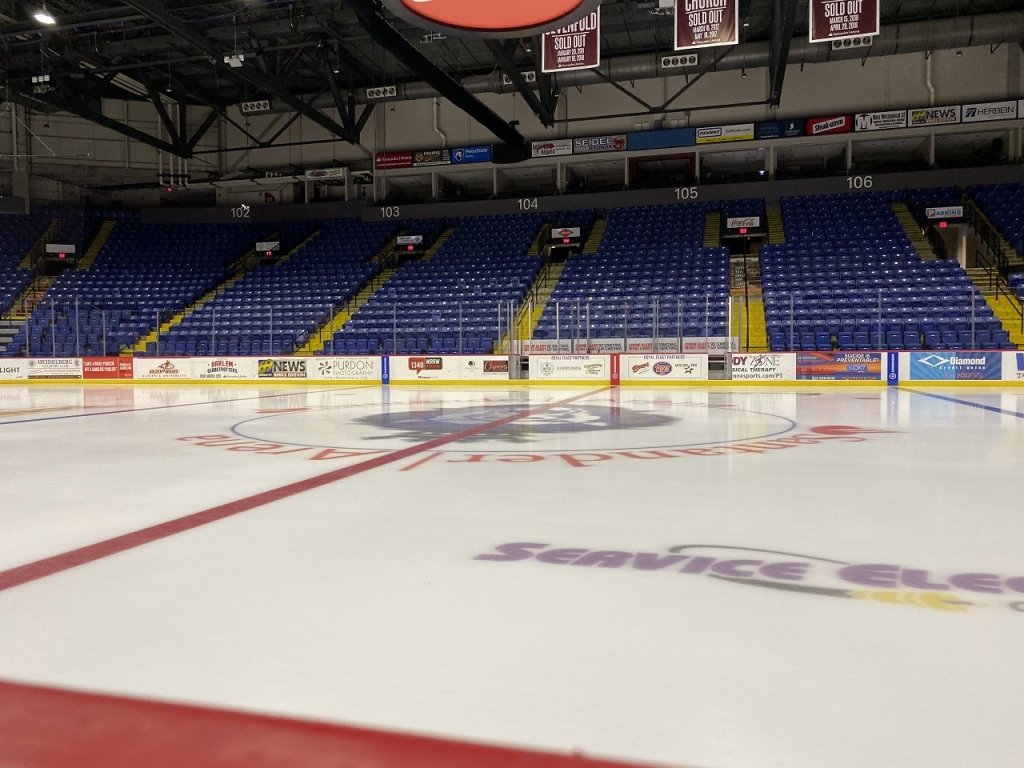 The Columbus Blue Jackets NHL rink, Image credit: Gay Lea Brampton
The Columbus Blue Jackets NHL rink, Image credit: Gay Lea Brampton
North America’s largest industrial refrigeration contractor, CIMCO Refrigeration (CIMCO) has been around since 1913 and has built more than half of the world’s ice rinks. The majority of these arenas use ammonia (R717) systems with CO2 (R744) ice arenas growing fast and surpassing 100 installs already.
Although the company was (and is) heavily focused on the ice rink industry, CIMCO also builds industrial refrigeration systems in other applications such as cold storage, petrochemical specialty applications, and food and beverage too.
Since 2021, the Canadian company, which is owned by Toromont Industries, has committed to using exclusively natural refrigerants in its ice arena designs, completely doing away with fluorinated refrigerants (f-gases).
We talk to CIMCO’s David Fauser (Director of Sales) and Brad Wilkins (U.S. Recreation Project Team Lead) about the company’s journey with natural refrigerants and the latest global ice arena refrigeration trends. Watch video

David Fauser, Director of Sales at CIMO
Brad Wilkins, U.S. Recreation Project Team Lead at CIMCO
Refrigeration Industry (RI): When did CIMCO first start using ammonia and CO2 in its designs? Take us through your journey with natural refrigerants.
David Fauser (DF): CIMCO’s use of ammonia goes back to our beginnings, 110 years ago, when our Founder Thomas Shipley moved from the U.S. to Canada to start the Canadian Ice Machine Company (CIMCO). Shipley was an inventor who held 22 patents. He was also quite prominent in the refrigeration industry, playing a key role in the establishment of what is today known as ASHRAE (the American Society of Heating, Refrigerating and Air-Conditioning Engineers).
Around 15 years ago, we started looking at CO2 more seriously too. We sent a convoy of lead engineering staff to Europe to further investigate these systems. Initially, the high pressures of CO2 were a concern, but as soon as manufacturers started making components that fit with CO2, we became interested.
We installed our first CO2 system at Concordia University in Montreal, Canada in 2013. Since then, we’ve done 125-150 more of these systems for the industrial and recreational markets – all of which are installed in North America.
RF: Why does CIMCO promote exclusively natural refrigerants in all of its recreational projects?
DF: Our core value has always been to supply our customers with long-lasting solutions. We no longer felt we could do this with f-gases. Not with the changing regulatory landscape and increasing pressure to phase down a growing list of f-gases. It is quite painful for a customer to take out a refrigeration system prematurely because of a regulation change.
We were also not comfortable with the often-misleading marketing used by the f-gas manufacturers, falsely touting these synthetic refrigerants as sustainable and long-lasting when the evidence clearly does not support this.
As such, it simply did not fit with us as an organization to promote anything but natural refrigerants to our customers. I know that we have lost sales because of it; I know that we have not been able to offer solutions because of it. But overall, it has been a better decision, because it gives us the peace of mind that our customers are getting the best long-term solution.
 A look inside Santander Arena’s plant room. Image credit: CIMCO.
A look inside Santander Arena’s plant room. Image credit: CIMCO.
RF: What are the key challenges you face with ammonia installations and how do you address these?
Brad Wilkins (BW): There is a lot of misinformation in the market about the safety of ammonia. As CIMCO, we know that 80% of the ice rinks in Canada have ammonia refrigeration systems. Ammonia has been around for a long time and it works very efficiently. The key is to respect the system and follow the required safety guidelines and regulations.
To further minimize the risk of ammonia systems, CIMCO has increasingly been installing low-charge ammonia systems with less than one pound of ammonia per ton of refrigeration. We also have a smart transfer system to automatically detect leaks and transfer the entire charge to a safe vessel without any humans involved.
RF: What about CO2?
BW: Pressure and performance in warmer climates are generally the two biggest concerns we see with CO2 systems, as well as serviceability. But, thanks to some big grocery chains in the U.S. switching all their stores to CO2, the serviceability and availability have greatly improved.
To deal with the pressures, system components have been specifically designed and manufactured for this purpose. We are comfortable with the design of these systems and we’ve seen them perform greatly in all applications (and climates).
RF: Please share a case study where you’ve successfully installed CO2 in an ice arena with significant benefits to the customer.
BW: The retrofit of the 8,000-seat Santander Arena in Redding, Pennsylvania (U.S.) comes to mind. CIMCO retrofitted the arena’s R22 refrigeration system with a CO2 plant in 2022. Thanks to this upgrade, the facility has realized annual energy savings of around 30-40%, despite the rink being busier than it was last year. Water savings of 30% were also recorded.
The quality of the ice has improved greatly by switching from R22 to CO2. Talking to the hockey players during practice, they commented on how much harder and more consistent the ice was throughout the year compared to the previous year. Before, the ice was soft, making it challenging to play on.
The new ice is so strong, the facility even hosted an event this year where motorcycles race around the ice. To achieve this, the ice had to be built up by three inches (8 cm) – no problem at all for the new CO2 system.
 The Columbus Blue Jackets NHL rink, Image credit: Gay Lea Brampton
The Columbus Blue Jackets NHL rink, Image credit: Gay Lea Brampton
RF: What about a cold storage or factory application?
DF: Currently, more than 40% of our projects are considering CO2. We have several examples of cold storage and food-processing facilities that have opted for CO2 with great success.
However, I am even more excited about the interest in natural refrigerants in markets where f-gases have traditionally been prominent. For example, we completed a new installation of a pharmaceutical plant for the Roche Group a few years ago where we used ammonia throughout the building for all HVAC systems. It has been working fantastic.
We are also currently working on a large ammonia HVAC system for a manufacturing plant. The company we are working with has a strong sustainability focus and wanted to ensure they had a sustainable solution from day one. This opens up a lot more opportunities for natural refrigerants as there is a huge market for chilled water/glycol applications.
RF: What does the natural refrigerant landscape look like in the U.S. and Canadian markets, particularly for ice arenas?
DF: We are seeing double-digit growth in our pipeline for natural refrigerants in ice arenas. About 40% of our total ice arena project pipeline right now, is CO2 opportunities – up from 30% last year.
BW: Previously, around 80% of our ice arena installs were ammonia systems. Now we are seeing a lot of systems being retrofitted from R22 to CO2 in Canada particularly. It is happening in the U.S. too, but it is moving comparatively slower. Still, opportunities for CO2 in ice arenas in the U.S. have increased by around 50% compared to three years ago. The biggest reason is concerns over R22 leaks and the risk of being forced to replace non-compliant f-gas systems prematurely.
DF: When you look at the pro hockey teams, we are replacing a lot of f-gas systems that were installed in the 90s and early 2000s. However, we are not talking to any teams that installed ammonia back then because those systems are still running fine.
We are seeing more CO2 arenas too, even in pro teams. Some have already pulled the trigger like the Columbus Blue Jackets NHL (National Hockey League) team that opted for CO2. We are also in discussions with other pro hockey teams, like the Washington Capitals, to switch their arenas to CO2.
RF: What about natural refrigerants in other applications? What trends do you notice in the U.S. and Canada?
DF: Within North America, we see predominantly ammonia being used for food processing and cold storage facilities in particular. It is a clear winner thanks to its proven efficiencies.
In Canada, CO2 is also increasing in the food and beverage, and cold storage sectors – particularly the smaller facilities. In the U.S., the uptake of CO2 in these applications is moving a bit slower.
 Santander Arena in the U.S. was retrofitted with a CO2 system, realizing significant utility savings. Image credit: @Landthins15)
Santander Arena in the U.S. was retrofitted with a CO2 system, realizing significant utility savings. Image credit: @Landthins15)
RF: Where do you think the natural refrigerant market is heading in the U.S. and Canada?
DF: Where I see natural refrigerants going is beyond just refrigeration. I almost feel that refrigeration as cold will become a dead topic, as crazy as that sounds. Because, when we think about cold, it's all relative – it is just heat and lack of heat. I really see a shift towards thermal.
If we really want to battle climate change, if we really want to maximize energy efficiency, deciding on what refrigerant to put in it just for the cold side is not going to be where we're going to find those savings. It is key to look at heating, cooling, and refrigeration all within one unit.
We need to come up with better ways to manage thermal energy throughout the building and where it's required. That is why CIMCO designed the Thermal Force One system that does heating, cooling, and air conditioning in one system, potentially doing away with natural gas boilers and their massive emissions.
Natural refrigerant systems, and especially integrated systems like this, offer a tremendous opportunity for our market to get to net zero and eliminate their natural gas or refrigerant direct emissions. Especially when you consider the opportunity for district heating and cooling systems with natural refrigerants.
I think natural refrigerants are here to stay; I think the market is going to grow; and I think there's going to be more pressure on and scrutiny of the f-gases. Ultimately, I think there is going to be an expansion of the usefulness of natural refrigerants within a thermal capacity of a building.
Thanks a lot for the interview! :)
Video interview with David Fauser, Director of Sales, and Brad Wilkins, U.S. Recreation Project Team Lead.
Ilana Koegelenberg is an experienced content creator and editor from South Africa, specialising in RACHP and sustainability stories. She holds a B. Journ degree from Rhodes University and boasts more than a decade of RACHP/HVAC&R industry experience. Previously Head of Market Intelligence at ATMOsphere (shecco) in Brussels, Belgium, she is also known for her role as Editor for RACA Journal and Cold Link Africa (among other publications).